
High school girl and high school boy sit on a couch. The girl clutches the boy’s arm to her chest and the boy reacts.
Or: Why I Should Be Guardian of Your Modesty
Time to take a break from writing about anime women (in the strictest sense, this post is going to have a lot to do with women as well as men) and start talking about men: the “target” demographic of ecchi anime. This season’s crop of Shows I Should Find More Amusing include a pair of anime that feature the common idea of unwanted molestation of men by women. For me, the subtext of these interactions rankles. Most anime men who have women throwing themselves at them seem to react poorly. Some can shout down the unwanted attention, but there are equally many leads who end up as doormats, frequently molested by their paramores. This upsets me on two levels: One is because it relates to the dual dichotomies of sexuality (Virgin/Whore and Knight/Beast) and secondly because the subtext of these interactions points to a monolithic understanding of gender interaction that leads men and boys to believe they are supposed to value sex highly and should do their best to ensure that women not behave like “sluts”.
Let’s start with the dichotomy idea because it’s probably more useful down the line. The Virgin/Whore Dichotomy is probably familiar to some of you. It encapsulates the general concept that women are either pure and good and therefore guarded in their sexuality, or evil and selfish and therefore free with their sexuality (hedonistic). This trope equates modesty and morality in most cases, but also explains why many women with healthy sex drive in the media are portrayed as slightly deviant (Nyarko is a good example we’ll get back to in a second). But it’s not only women and girls who suffer from a broad social narrative; an application of Ozy’s Law (misogyny mirrors misandry) reveals the Knight/Beast Dichotomy on the other side of the gender coin. Knight/Beast pits men in control of their desires as protectors and saviors and opposed to men who are not in control of their desires as monsters. Some problematic myths about rape and rapists come from this duality, but they’re out of the scope of this post. If you’re interested, I highly recommend you read up on them at No, Seriously, What About the Menz? when you have some time. For the purposes of this examination, however, I want to talk about the idea of Knight and why it might cause someone like Teiichi Niiya of Dusk Maiden spend most of an anime protesting to the sexual advances from girls for whom he might have feelings.
In Dusk Maiden, we see Teiichi playing both the part of the blushing virgin and the dashing hero, which seems at first in conflict. Normally, the patriarchal concept of the “sexual marketplace” places the man in the position of sexual aggressor, because it is he who wants sexytimes. The women, then supposedly trade it for things like “emotional involvement” or “financial stability” (this, of course, bullshit). If this is the case, why, then do Teiichi and Mahiro Yasaka (of Haiyore! Nyaruko-san) back down? Aren’t they supposed to be the ones who want it? Well, when the women take the first move, the men have to button up their urges and play the part of reluctance. We rarely see a lusty woman pared with a perverted man, and so I think this tension surfaces for three reasons. First, it provides room for development. It certainly appears that Teiichi’s diminishing prudishness forms a central part of the main relationship’s evolution. But, less favorably, these interactions can also be used to define the woman as ‘evil’. Nyarko and Yuuko’s lust gives them a dark edge that subtly contradicts their expressed benign nature. Had Mahiro or Teiichi showed equal interest (equal is important. Teiichi shows SOME interest, but his reluctance adds a slightly squicky undertone to their interactions), the characterization would dissolve. Ozy’s Law is once again at work in defining the “good guys” from the seductresses by their chaste refusal. The self-control on display runs slightly contrary to the idea of active male sexuality as part of hegemonic masculinity (the idea that it’s the men with base impulses on the whole and that women have no interest in sex, but also the idea that you should like sports more than fashion or meat more than veggies).
We can approach these common tableaux on two levels. First, the idea is that while we all wink-and-nod at our harem heroes as they try not to act in an untoward manner, the message is clear that “good” boys don’t give into temptation and that’s what makes them heroes. The message is pervasive powerful. Notice how most otaku choose one waifu and that the “pure” and “innocent” ones make the most desirable targets? We value chastity in our women and understand overactive sexuality as degenerate–this is the reformation narrative of Makoto Ito from School Days and explains why he chooses Kotohana Katsura at the end from a moral point of view: the reformed beast needs a maiden, not his lusty, pregnant best friend. Not good enough? How about Akuto Sai choosing Junko Hattori even after his ascension to Demon Lord in Ichiban Ushiro no Daimao? Or Minato Sahashi’s (Sekirei) continued choice to remain celibate in the face of a growing personal army of women who throw themselves at him every day? Harem shows gravitate to the “harem ending” because of a tension between fan-wank and the desire morally to place the lead with the “childhood friend”. It’s only the newer shows like Amagami and Yosuga no Sora (I just threw up a little in my mouth. That’s how much I love you guys) that balance between routes and don’t offer up a “true” pair.
I still wonder why we so frequently pair these boys and men with women so ready to tear off their clothes. This last idea overreaches a little, but you know what? I’m having fun so, let’s go all out. I think we can build a gender-policing case that the other part of the “Knight” role is to protect women from their own sexuality. Mahiro’s fork keeps the over-affectionate Nyarko’s perversions in check, which seems like a public service given that she is a godlike being from the far side of the galaxy. The juxtaposition between Mahiro’s prudish behavior and Nyarko and Cthuko’s voracious sexual appetites furthers the otherness of the aliens even as they inhabit human forms and helps us sympathize with the lead’s assertion that despite their professed good intentions they’re up to no good. In this way, the narrative positions him between the insatiable aliens and our planet like… Well, like a White Knight. Hmmmm…..

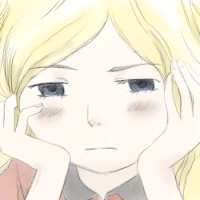
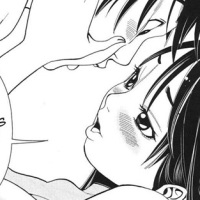
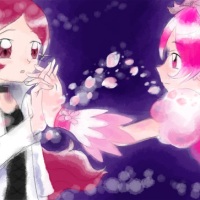
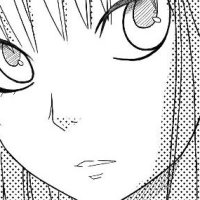

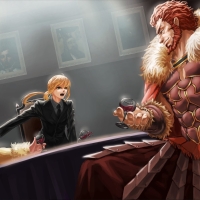





OOOOR you can even view this from a yet more patriarchal view. Taking the Knight/Beast and applying it to women the Angel/Beast, we can see chaste men as a “beast keeper”. Exerting their control over the women’s sexuality by denying them sex. Thus once again men are placed into the position of controlling women’s sexuality. “By darn it I’ll make you a Madonna!”
Yep. That was the point of the last paragraph, but wasn’t sure that these texts in particular supported it. I think there’s a strong case to be made in School Days… AJ?
School Days pretty much ended my insipid curiosity in the harem genre forever. How? It successfully pulled off a deconstruction of the genre by turning Makoto into a “beast,” in stark contrast to the standard “knight” of the majority of harem anime.
Interesting, and perhaps conducive to the “madonna/whore” lens presented here, that the development in recent episodes has suggested that Nyarko’s overt sexuality is (maybe) a pose. In fact, when she comes out to him with her feelings in a shy, more madonna-like way, that finally catches Mahiro off-guard.
That said, Nyarko’s behavior returns to normal almost immediately, as do Mahiro’s reactions—suggesting, as you say, that his role is to “police” sexuality and that he can only deal with romance if it’s presented in a sexless way.
Maybe the concept is even fully salient to the producers, and they’re playing with it, since Nyaruko hasn’t been shy about casting most of its characters as horrible people in the first place.
Spot on (I am little behind on Nyaruko-ani, so I only know of the changes based on what I’ve readon blogs, but it seems to jibe with your assessment). That behavior of the leads in response to sincere “romantic” advances also plays out over and over again in Dusk Maiden (Yuuko has more success when she plays up her vulnerability and sentimental feelings for Niiya than when she mashes her tits into his face).
I think the issue of whether it’s deliberate is about how mercenary or lazy we feel the creators are. I personally hedge towards an unintended use of a popular trope since it’s more about ignorance of what they’re saying instead of them trying to deliberately abuse a kind of nasty idea. Had the creators really played with this stereotype by making Niiya or Mahiro more willing, I might feel they were aware, but this seems more like a “we’ve always done it this way” kind of thing. But I could be wrong.
I haven’t watched the shows mentioned, but I do know about the Madonna/Whore dichotomy. I just learnt the male counterpart here and thus I’m very grateful :) I don’t like dichotomies in general and sexual advances that go over the borders without consent annoy me from whatever gender they come from.
It’s very interesting how things can be read in multiple ways in any case
All of those things are negative, so it’s probably okay to not like them. ;)
The point about consent is extremely salient, as if you notice, the humor derived from the advances of men on women comes at the expense of the creepy, perverted dude, whereas the humor from women’s advances on men comes from the mewling male reaction (why would a dude refuse sex?). This feeds into a nasty idea that men can’t be raped by women (not true!) because only the deviant don’t want it.
Anyway, thanks for your comment! ^_^
I’m not sure that this is an actual flip. (Also, I don’t like the way you have labeled your dichotomies and am not sure that in the context of this discussion that “rapist (Beast)” and “Whore” are proper comparisons. I’d have gone with Man-Whore, but I think Rogue is more traditionally accepted, if also more normatively loaded.)
I think there are two relationship structures assumed inside the “prude vs. bawdy” relationship: “Predator and prey,” and “dominant and submissive.” Traditionally, the male is assigned the role of both predator and dominant. In the relationships that you describe, only one of those is explicitly flipped. While the male is the sexual “prey,” it appears to be assumed that he is still more or less “in-charge” of the relationship and its direction. That, I think, is whether suspicions of gender-policing come in. Otherwise, it is easy to point out that there are many stories where a woman “reforms” some Man-Whore into a Knight and this is just the inverse. Only MRAs claim that women are controlling that man’s sexuality.
But because it is not truly a flip in the relationship, but only a partial one, the effects and even the outcomes are different.
Thanks for the comment. :D
I think we’re mostly in agreement, so maybe I wasn’t as clear in my post as I would have liked. You’re absolutely correct that there is no real inversion if the man remains “dominant” as you said, and that was part of the point I was trying to suss out. Even when she makes the advances, these stories refuse to really put the women in control of their own sexuality, which does reinforce the central ideas of the patriarchy where liberated feminine sexuality will bring ruin to everything.
I do, however, have to disagree with your definition of Man-Whore instead of beast. Hegemonic maleness assumes that men want sex and that having it increases their social status. For men, sex is the END not a means. The “Whore” idea is rooted in the assumption that women don’t seek sex for its own sake, but instead are using it as a means to obtain something else they want (MRAs believe money/dominance, PUAs believe “emotional support” or money). The “Beast” role fits better with this sexual dichotomy because it differentiates the virtuous men who only sex up willing partners from those who go out and take what they want. The difference can be seen when looking at School Days, on which I really want to write if I can convince AJTheFourth to go in with me. XD
the idea seems noble and all but in most cases, the males are healthy teenage boys who have needs, if you know what I mean. I always imagined that at least they will grow a tent when the female characters start to “molest” them but instead they shy away with obviously no sexual intention. That makes me see them as UNhealthy teenage boy instead and nothing like a knight/beast.
So… This isn’t going to be pleasant.
Claiming that “healthy teenage boys have needs” is part of the problematic culture from which this narrative arises. How you feel about the unsolicited sexual advances of girls or women has no bearing on how other men or boys feel and claiming that their reluctance is unhealthy furthers a pretty damaging idea of how male sexuality works (I’m not attracted to this girl! Is there something wrong with me?!).
Or society, as is, has a huge problem with consent in general and the idea that men always want sex erases any men who have been sexually assaulted by women, and makes it really hard for men in general to operate under the idea that their bodies are theirs.
ADDITIONALLY, the idea that the male sex drive is independent of what a man might want is at the core of the “Beast” concept. It’s the idea referenced when men claim that they can’t control themselves around provocatively dressed women–“It’s not my fault! I’m a man! YOU’RE the one scantily clad!”. You can see how this gives rise to a number of problems.
In short, each man or boy is his own person and treating him as such helps us both listen to his problems and place on him the responsibility for his actions.
I think it might be interesting to contrast these series with two others airing this season: in Mysterious Girlfriend X, the boy is pretty “normal”, almost refreshingly so: a little curious, a little considerate/hesitant; and the girl is wonderfully in control and matter-of-fact (and yet, at times, the show seems almost creepily perverse!). The other relationship in the series — the other couple — seem to have a healthy and positive attitude, too.
The other series to consider is Hyouka. Chitanda is constantly invading the male lead’s space; he at least feigns reluctance. But it’s all so innocent! Yet sometimes the pendulum on the clock has a heart-shaped weight and the world takes on a rosy color as it seems like she is going to confess. No Virgin/Whore, no Knight/Beast, just two people who complement each other well.
I can’t speak to MGX. Maybe bitmap can weigh in. But Chitanada, I can talk about quickly.
While you make an interesting parallel, the Virgin/Whore and Knight/Beast dichotomies mainly concern sexual politics. Chitanda’s relationship to Hotarou is currently platonic, and so the same ideas don’t apply. I didn’t make a large deal of it, but the idea behind the comparison is rooted in the “tradtional” difference between how the genders view sex. There is, however a strong seduction narrative at work I think in Hyouka (the hair scene in the first episode is pretty hamfisted).
That said, notice how emasculating Hotarou’s compliance appears to be. He appears more “heroic” and cool when solving the mysteries because he takes the lead (notice how once he’s on a role, he’s the one who issues the orders). I think you’re onto something overall with the relationship between bossiness and perceived masculinity (note how anime tomboys tend to be really bossy: Think Chihaya).
This is an interesting post. Let me make sure I have the basic argument correct before I proceed:
There exist two dichotomies, virgin/whore and knight/beast; in general, we have whores paired with knights, which opens up space for development (which is ok) AND re-enforces notions of sex as valuable and licentiousness as deviant. (which is highly problematic for reasons stated in your piece.)
While I most definitely agree with your argument, I think there are other forces at work here. The chaste refusal of males can be read as a self-check against “unleashing the beast”, but can also simply arise out of a lack of interest. (“I do want to have sex, just not with YOU.”) I argue that Mahiro (from Nyaruko) is more aptly characterized by his belligerent lack of interest than chaste restraint. It’s fair to say that I would react to unwanted sexual harassment equally belligerently. None of this changes the fact that licentious women, like Nyaruko, are still considered “evil”, which is incredibly problematic. Nevertheless, not all men are knights, just as not all men are beasts. Some simply don’t want to have sex (knights), some don’t want to have sex with a particular woman (disinterest), and some want to have sex with women, but not at a particular moment in time (unreadiness). I wonder how considering these alternative narratives would change your argument? I’m not quite sure myself, but it’s something to think about.
In addition, the takeaway message from School Days was most certainly not one of reformation. If anything, School Days really demonstrated what happens when one “unleashes the beast” without agenda or consideration. I do not believe Makoto was “reformed.” If anything, he ran back to Kotonoha in a fit of desperation. (Remember his frantic and futile booty-calling to the penultimate episode? Yeah, that.) We should abhor Makoto for his shameless exploitation of Kotonoha, which explains why he gets his just desserts in the show’s finale.
Finally, I think that the recent change in shows like Amagami and Yosuga no Sora have almost nothing to do with changing notions on gender and everything to do with changing patterns of anime consumption. I’ll lay out that argument some other time, but I think the underlying sexist subtexts are very much alive and well.
In reverse order because that makes more sense (^_^):
– I mentioned Amagami and Yosuga more to demonstrate I’d heard of them than for the sake of argument. Many harem shows follow one lead, many women at once, but I these two deviate. I didn’t want fans screaming that I’d forgotten them. It’s my completionist brain at work.
– School Days does deserve its own post, but here’s what I was getting at: It has less to do with how Makoto ends up and more that after sleeping with all these women, he chooses the chaste, shy girl from the start of the show. True, his motivation can be any number of things about Kotonoha, but when placed in a larger context, we generally see that men tend to choose the blushing maidens over their lusty alternatives, and that’s at problem in an of itself.
– On your initial point, it’s true that he might not be interested in HER, but then we get back to the School Days point. Usually when harem heroes turn down a woman who is forward, it’s to run into the arms of a “nice” girl (see: Kotonoha, Serenia Flameheart, Junko Hattori, and I’m sure the list is longer). When that’s not the case we see that only by backing off does the girl or woman get the man she wants (see: Yuuko or Chizuru from Kanokon). Truth is, the coding of the pervert women is such that the narratives never feel the need to explain why the lead doesn’t like these women. Maybe this is less a concern when the tone borders closer to sexual assault than something like Dusk Maiden, where Teiichi clearly LIKES Yuuko, but maybe wishes she didn’t like him as… vivaciously.
The issue here is not that Mahiro in particular, when examined closely doesn’t like Nyaruko because she wants to have her way with him, but more that his relationship with her mirrors a common, problematic situation.
I see how Akuto from Demon Lord plays into this, in that his rejection of the other, more aggressive female characters plays into the dynamic you outline, but I sort of wonder if the makers were trying to play with the concept a bit rather than do the conventional thing.
In most series, these female advances tend to be over-the-top and the male rejection violent in an attempt to emphasize the “rightness” of the disciplined male controlling the woman’s sexual aggression. Admittedly I haven’t watched the series in awhile, but I seem to recall that In Demon Lord Akuto typically either rejects these advances politely or misinterprets them (sometimes intentionally). Akuto also stands out among harem protagonists in that he never expresses anything more than amiable friendship and platonic interest in any character other than Junko. This rejects, in part, the typical construction of harem anime. Typically they are about the male and his power to choose among various willing female partners. Yet Akuto has already made his choice, knows it, and is up-front about it with everyone from the first episode; he is interested in Junko and Junko alone and the rest of the series, from a romantic perspective, is a comedy of errors as he attempts to prove his sincerity and worthiness to her. In a similar way, while in most harem shows it is by backing off or “freeing” the protagonist to pursue other women that the “chaste girl” wins his heart, Akuto and Junko’s relationship, while certainly teased throughout the series, is only established near the end when she asserts her affection for him, regardless of the consequences.
In that it is still a show about how the lead inexplicably attracts every female who meets him it still plays in to some harem conventions, but I generally got the feeling that this was more to mock or satirize them than to strengthen them.
So, the gender politics of Demon King Daimao are interesting (http://aboutwaifuz.tumblr.com/post/9385274757/you-are-the-demon-king), but that doesn’t obviate the fact that Junko is considered “good” while Fujiko Etou is considered “evil” even by her own admission. True, Akuto doesn’t really end up with any of them, but their coding on the moral axis maps onto their promiscuity according to the “traditional” rubric, which supports the above thesis. A subversive account would have these turned on their head.
Thanks for commenting, though. I DO so love Demon King Daimao, despite some of its problems.
There’s something I want to bring up here, though. The hesitant males in these harem shows… I’ve always figured that their behavior was a necessity of the genre.
One boy and multiple girls. All of the girls likes the boy. Hijinx ensue.
This allows a constant state of randomness to happen. When the boy hasn’t decided on one girl, the writer is free to handle all the characters as he sees fit. If suddenly the boy and one girl get too close, the writing gets actually complex and the equilibrium is broken.
In addition to maintaining status quo and simplicity, it’s also a question of holding off the inevitable. I am confident there are readers to be gained by keeping as many of the girls “virgins”. This is probably particularily true in japan (look at “idol” fan reactions when such and such “idol” reveals she has a boyfriend). In short: If the main character stays away from the girls, the girls are “unspoiled” and thus less likely to cause reader-rejection. I don’t think this is that big of an issue, though. I’m sure the more important issue is to keep the manga/anime going, and that includes having that boy reject girl thing going.
I SEE where you’re coming from, but there are definitely some problems there. Let’s see if we can suss them out.
First, the idea that the writing becoming more complex excuses the shoddy characterization and unoriginal dynamic is pretty weak. A good story would strive to provide fully-realized characters and then ensure that the plot worked with them to deliver a fun experience while not selling itself short. Saying that this pattern might be the product of laziness might be TRUE but that doesn’t make it OKAY.
But let’s examine the “readers gained by keeping as many of the girls ‘virgins’,” angle, because… yikes. The idea here is that the anime women–like regular women?–have value only so long as they remain unsullied. Any why? It mirrors the idea in society that a woman’s virginity is a thing she GIVES to a man and that thing has VALUE.
This is an old idea that works to control women through their sexuality. See, a woman’s worth is defined by her desirability (an anime girl is only interesting insofar as she is waifu material), and that desirability is in no small part contingent on her virginity. At the blindingly obvious level, it equates the value of a whole person/character with that one trait, kind of awful, no? But that’s, of course, not the worst of it.
On a second order, this idea sends a clear message to girls and women that being sexual and in control of your sexuality is bad (here we are in madonna/whore territory). So long as hordes of rabid otaku scream “SLUUUUUUT” at every one of their precious girls who so much as looks at another boy they’re sending a clear message to the women in the vicinity that they are not to behave the way that they want to, but instead the way MEN want them to.
Which was my point about the chaste choice being problematic. So long as the innocent, virginal girl gets the guy, it continues to reinforce the horrible ideas that women can’t pursue, that men are not interested in women who are in control of their sexuality, and that women who are are as a result inherently “bad”.
Sure this might SEEM extreme, but any setup that reinforces a “traditional” version of sexual politics is not in line with a world where men and women are equal, whether or not it’s what’s familiar.